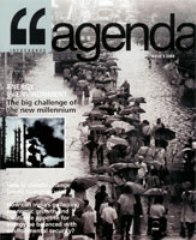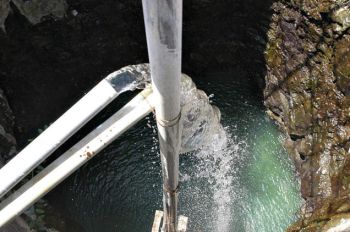/topics/climate-and-weather
Climate and Weather
Long range forecasting of the South West Monsoon for 2011 - A report from India Meteorological Department
Posted on 19 Jun, 2011 10:04 PMIn India, SW monsoon is the principal rainy season and it receives about 80 per cent of its total annual rainfall during the summer monsoon season, from June to September.
"Climate change" - Understanding the connections with energy use, and how India's galloping economic growth and insatiable appetite for energy can be balanced with environmental security?
Posted on 18 Jun, 2011 12:52 AM
Introduction: Energy versus emissions: The big challenge of the new millennium
By Rakesh Kalshian
To maintain its economic growth rate of 8-10%, India needs all the energy it can get. But the momentum of economic growth overrides crucial environmental concerns.
Hotting up: The science and politics of climate change
By Aditi Sen
The world is hotting up. Climate systems are changing. The 1990s were the hottest decade ever, sea levels rose by 10-20 cm during the 20th century, and atmospheric carbon dioxide levels are 31% higher than in 1750.
Call for entries to fifth annual 'Postcode Lottery Green Challenge' - Apply by July 29, 2011
Posted on 17 Jun, 2011 05:07 PM The Postcode Lottery Green Challenge is for people who can instigate change – creative, innovative thought leaders and their organisations.
The Postcode Lottery Green Challenge is for people who can instigate change – creative, innovative thought leaders and their organisations.
The Postcode Lottery Green Challenge, an initiative of the Dutch Postcode Lottery, calls on creative, innovative thinkers around the world to submit ideas for green products and services. This is an international competition that welcome ideas for sustainable, creative and innovative products and services. The winning inventions must reduce CO2 output and be realisable within two years.
Accelerated programmes - What can the water sector learn from the power sector? – An article in EPW by Tushaar Shah
Posted on 16 Jun, 2011 09:11 PMThe Government of India’s 15-year old AIBP has come under much-deserved criticism for all-round non-performance. It was introduced to support states in "last mile" public irrigation projects, that is, projects which are nearly completed but whose full benefits can start flowing only after small, incremental investments are made. Yet, the AIBP has been used mostly for funding new projects.
Managing shallow aquifers in a city
Posted on 16 Jun, 2011 06:04 PM Good option: The city needs multiple sourcing of water and open wells have the potential to provide up to a third of the requirement
Good option: The city needs multiple sourcing of water and open wells have the potential to provide up to a third of the requirement
Just how a city can be arbitrary with its policy on water management and therefore leading to sub-optimal conditions is made clear by a recent example one came across. Balasubramanian had an old open well dug to a depth of 30 ft. when he first built his house in the early 80s. The well had yielded water for quite some years but then subsequently had gone dry.
Indian Youth Climate Network is looking for ten positions in its Organisation Development Unit
Posted on 15 Jun, 2011 12:03 PM
The Indian Youth Climate Network (IYCN) is a network of young people in 18 states who are concerned about climate change & environment issues. The purpose of IYCN is to bring the voice of Indian youth on the global platform as South Asia is one of the most vulnerable regions affected by potentially catastrophic climate change & environment issues.
Changing with the seasons: How Himalayan communities cope with climate change - A report by Peoples’ Science Institute
Posted on 14 Jun, 2011 10:51 PMMountain areas and communities are susceptible to climate change. This work also yielded evidence of the coping strategies developed by the communities to deal with an unprecedented and only partially understood threat. This paper describes these strategies and attempts to assess the vulnerability of the communities in each valley.
Snow and glaciers of the Himalayas – A study by Indian Space Research Organisation
Posted on 14 Jun, 2011 07:58 PM The study on “Snow and Glacier Studies” was taken up by the Space Applications Centre, Indian Space Research Organisation (ISRO) and executed in collaboration with fourteen research organizations and academic institutions of the country, at the behest of the Ministry of Environment and Forests.
The study on “Snow and Glacier Studies” was taken up by the Space Applications Centre, Indian Space Research Organisation (ISRO) and executed in collaboration with fourteen research organizations and academic institutions of the country, at the behest of the Ministry of Environment and Forests.
Himalayan mountains contain important natural resources of frozen fresh water in the form of snow and glaciers. These glaciers are unique as they are located in tropics, high altitude regions, predominantly valley type and many are covered with debris.
The great northern plains of India sustain on the perennial melt of snow and glaciers meeting the water requirements of agriculture, industries, domestic sector even in the months of summer when large tracts of the country go dry. Therefore, it is important to monitor and assess the state of snow and glaciers and to know the sustainability of glaciers in view of changing global scenarios of climate and water security of the nation. Any information pertaining to Himalayan glaciers is normally difficult to be obtained by conventional means due to its harsh weather and rugged terrains.
Patkhori's water solutions - A case study from the work of SM Sehgal Foundation in Mewat, Haryana
Posted on 14 Jun, 2011 05:27 PM Community water tank
Community water tank
Long range forecast for 2011 South-west Monsoon season rainfall - Press release by IMD
Posted on 14 Jun, 2011 03:39 PMThe Long Period Average (LPA) of the south-west monsoon season rainfall over the country as a whole for the period 1951-2000 is 89cm. The first long range forecast for the south-west monsoon season (June-September) rainfall is issued in April and the forecast update is issued in June.





